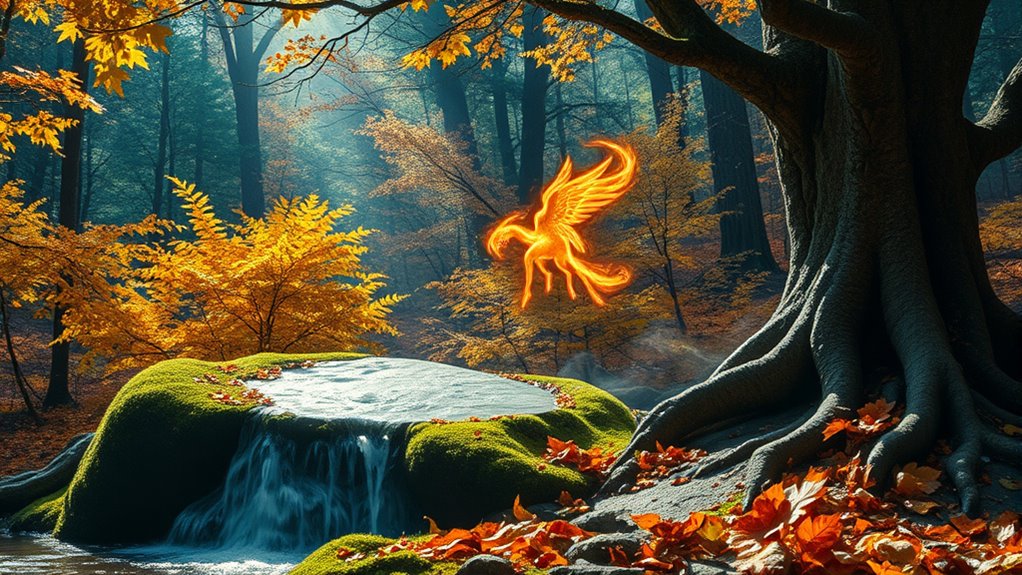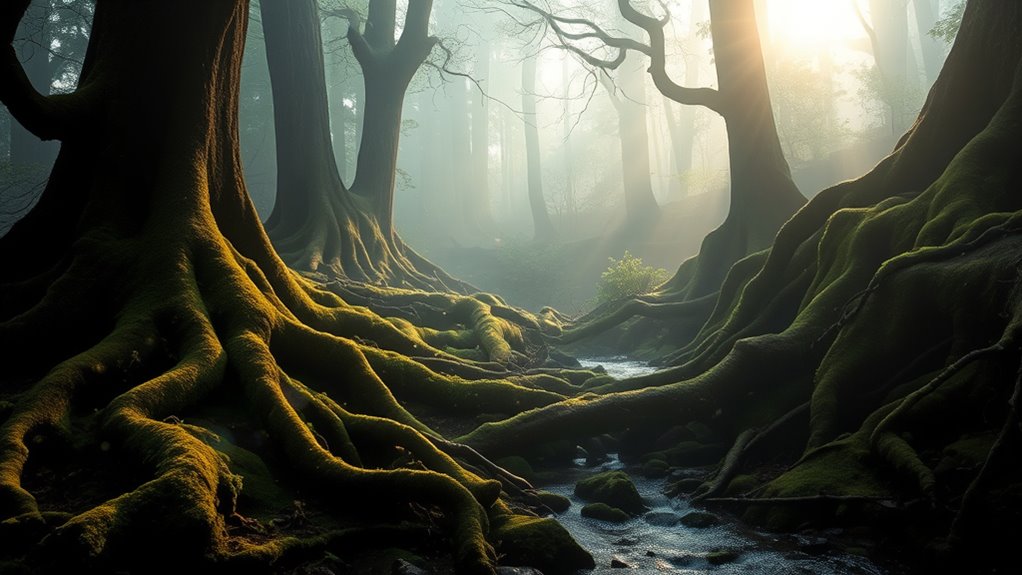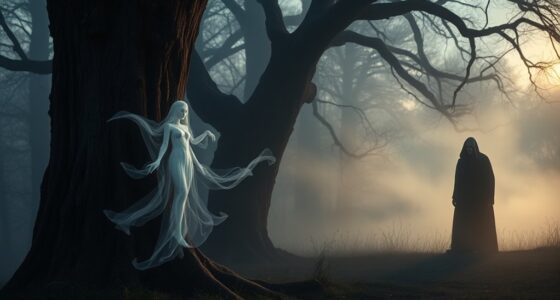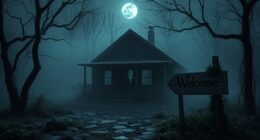Elementals are nature spirits linked to the four classical elements—earth, water, air, and fire. They’re seen as guardians of the natural world, influencing their respective elements. Unlike ghosts, which are spirits of the deceased, elementals actively manipulate natural forces. They can exhibit varied behaviors, sometimes causing disturbances in their environments. Understanding these mystical beings can deepen your connection to the natural world, revealing fascinating insights that go beyond the surface.
Key Takeaways
- Elementals are non-human entities linked to the four classical elements: earth, water, air, and fire, acting as guardians of nature.
- Unlike ghosts, which are spirits of deceased individuals, elementals manipulate natural forces and can show aggressive behaviors related to their elemental nature.
- Signs of elemental presence include strange environmental disturbances, unusual animal behavior, and compulsions to be near specific elements like water.
- Cultural rituals often aim to prevent disturbances from elementals, reflecting their significant role in folklore and human fascination with nature.
- Modern interpretations view elementals as metaphors for ecological balance, bridging ancient beliefs with contemporary environmental awareness.
Definition and Origin of Elementals

Elementals, as you may know, are fascinating non-human entities tied to the four classical elements: earth, water, air, and fire. These elemental beings embody the very forces of nature and are believed to influence their respective elements, acting as guardians of the natural world.
The concept of elementals originated during the European Renaissance, with occultists like Paracelsus classifying them into distinct categories: gnomes for earth, undines for water, sylphs for air, and salamanders for fire.
Over time, these nature spirits have woven into modern beliefs, appearing in Wiccan practices and paranormal phenomena. The term “elemental spirits” has roots in ancient Greek, reflecting the deep connection between these entities and the fundamental principles of nature’s forces.
Elementals vs. Ghosts

When you explore the domain of the paranormal, it’s essential to understand the distinct characteristics of elementals and ghosts.
While ghosts are the lingering spirits of the deceased, elementals are nature spirits tied to the elements. Their behaviors can overlap, but recognizing these differences can shape your approach to any investigation.
Distinct Characteristics Explained
While many people might confuse elementals with ghosts, they represent fundamentally different types of entities in the paranormal domain.
Elementals are non-human supernatural entities tied to the four classical elements: earth, water, air, and fire. They act as guardians of their respective elements, often manipulating natural forces or causing environmental anomalies.
In contrast, ghosts are spirits of deceased individuals, usually lingering due to unfinished business or emotional attachments to specific locations.
While both can exhibit poltergeist-like activities, elementals tend to display more aggressive interactions linked to their elemental nature, whereas ghosts often manifest in more passive ways.
Understanding these distinct characteristics helps clarify their roles within the natural world and the paranormal domain.
Behavioral Differences Observed
Understanding the distinct characteristics of elementals and ghosts sets the stage for exploring their behavioral differences.
Elementals, as non-human nature spirits, often act as guardians of their elements, showing behaviors linked to earth, air, fire, or water. Unlike ghosts, which may linger due to unfinished business, elementals exhibit actions that can range from mischievous to aggressive. You might notice water elementals causing plumbing issues or air elementals throwing objects.
Conversely, ghosts typically create cold spots or disembodied sounds, focusing more on communication with the living. Their encounters often feel less threatening compared to the emotional disturbances and unusual animal behaviors caused by elementals.
These behavioral differences highlight the unique roles each plays in the paranormal domain.
Types of Elementals

Elementals are fascinating beings that embody the four classical elements: Earth, Water, Air, and Fire. The types of elementals include Gnomes, Undines, Sylphs, and Salamanders, each with unique traits.
Earth elementals, or Gnomes, are small, bearded guardians of rocks and minerals, often found in caves or wooded areas.
Water elementals, known as Undines, are emotional beings connected to bodies of water, resembling mermaids or nymphs, and embodying fluidity.
Air elementals, called Sylphs, are graceful beings linked to winds and clouds, inspiring creativity and thought.
Finally, Fire elementals, or Salamanders, manifest as light or fireballs, representing transformation and energy.
Understanding these types of elementals can deepen your connection to the natural world.
Signs and Effects of Elemental Haunting

Have you ever felt an unsettling presence in a quiet, natural setting? This could be a sign of an elemental haunting.
These entities often thrive in isolated areas, causing disturbances that can affect your mental balance. If you’ve experienced strange plumbing issues or felt a compulsion to be near water, you might be encountering water elementals, known as undines.
You may also notice unusual animal behavior, which can indicate their presence. In haunted houses, ghost stories often mention mischievous earth elementals, appearing as small bearded men and provoking fears related to burial.
To maintain harmony, many cultures perform ritual offerings, hoping to prevent disturbances caused by these elemental beings.
Stay aware of these signs; they could be more than just your imagination.
Investigating Elementals in Paranormal Research

When exploring the signs of elemental hauntings, researchers often turn their attention to the methods used to investigate these elusive entities. They employ specialized equipment like EMF meters and temperature sensors to pinpoint environmental anomalies that may indicate elemental activity.
| Elemental Type | Indicators |
|---|---|
| Earth | Sudden temperature drops, animal behavior |
| Fire | Spikes in heat, unexplained fire phenomena |
| Water | Unexplained moisture, strange sounds |
In the world of the paranormal, understanding the cultural context of elementals can also enhance investigations. Elementals typically thrive in natural settings, making rural locations prime targets. By noting these signs, you can gain insights into the spirits that inhabit our environment.
Modern Interpretation of Elementals

When you think about elementals today, consider how they serve as metaphors for the forces shaping our world, like the elements in science.
Many people now see them as symbols reflecting ecological balance and environmental awareness.
This modern perspective invites you to explore their influence on both nature and human emotions.
Scientific Perspectives on Elementals
While many people view elementals as mystical beings from folklore, modern interpretations suggest these entities can be understood through the lens of contemporary science. You can think of elementals as representations of the elements in the periodic table, connected to natural processes. For instance, an “oxygen elemental” signifies combustion and respiration, while a “carbon elemental” reflects organic matter and climate change. This perspective transforms elementals into metaphors for the fundamental forces driving our world.
| Element | Associated Elemental |
|---|---|
| Oxygen | Oxygen Elemental |
| Carbon | Carbon Elemental |
| Water | Water Elemental |
| Fire | Fire Elemental |
This evolution from supernatural beliefs to scientific interpretations illustrates how we can understand elementals in modern times.
Elementals as Metaphors Today
How do elementals fit into our modern understanding of the natural world? Today, elementals can be seen as metaphors that help you connect with the natural environment. They bridge ancient folklore and legend with contemporary scientific concepts, representing essential elements like oxygen and carbon that are vital for life.
- An oxygen elemental symbolizes respiration and combustion.
- A carbon elemental reflects organic matter and climate change.
- Elementals serve as guardian spirits, reminding us of the unseen forces that govern our world.
This modern interpretation encourages you to think about environmental stewardship and the need for ecological balance, emphasizing your responsibility towards preserving the natural world.
Elementals, in this sense, become powerful symbols of our interconnection with nature.
Elementals in Literature and Popular Culture

Elementals have long captured the imagination of writers and creators, serving as both symbols and characters in various narratives.
In Michael McDowell’s novel “The Elementals,” these beings are portrayed as deceptive, linking to ghostly encounters and folklore.
Popular culture often depicts elementals as guardians of nature or mischievous spirits, reflecting their roots in Paracelsus’ classifications like earth elementals, gnomes, and more.
In modern fantasy literature, elementals become magical beings that can control their elements, shaping plots and character dynamics.
You’ll find them in role-playing games too, where they serve as powerful creatures players can summon.
Scientific Perspective on Elementals

What happens when we examine elementals through a scientific lens? You’ll find that the concept of these beings is largely dismissed in modern science.
Elementals, rooted in historical beliefs and folklore, lack empirical evidence and don’t align with the principles of physics and chemistry. The scientific perspective emphasizes:
- Classical elements like earth, water, air, and fire have been replaced by the periodic table.
- The existence of elementals remains unproven, often viewed as metaphors rather than reality.
- Ancient beliefs about elemental forces don’t fit with current scientific understanding.
In essence, while elementals serve cultural and mythological roles, they don’t hold weight in the physical world as recognized by contemporary research.
Frequently Asked Questions
What Are Elementals in the Spirit World?
In the spirit world, elementals are unique entities tied to nature’s fundamental forces. You might encounter them in places where the earth, air, fire, or water reigns supreme.
Unlike ghosts, they don’t originate from human souls, but instead embody the essence of their elements. You could feel their presence during storms, in lush forests, or near water bodies, often sensing their influence on your emotions or the atmosphere around you.
What Is the Difference Between an Elemental and a Demon?
When it comes to the supernatural domain, the difference between an elemental and a demon is like comparing night to day!
Elementals are nature spirits tied to earth, air, fire, and water, often acting as guardians. They’re generally harmless and sometimes even helpful.
In contrast, demons are often malevolent entities, believed to manipulate and create chaos.
Understanding this distinction is vital when traversing paranormal encounters, as it shapes how you protect yourself in those situations.
What Are Paranormal Elements?
Paranormal elements refer to supernatural entities that embody the forces of nature. You might encounter these beings in various forms, each representing an element like earth, water, air, or fire.
They’re often seen as guardians of their respective domains, influencing the environment around you. Unlike ghosts, these entities aren’t the spirits of the deceased; they exist independently, making them unique players in the mystical landscape you explore.
Their influence can manifest as strange natural occurrences.
What Are the 4 Elemental Demons?
Imagine the tranquility of a serene lake contrasted with the fury of a raging fire.
Now, consider the four elemental demons:
Gnomes, the mischievous guardians of Earth, keep secrets of minerals;
Undines, the emotional spirits of Water, embody grace and beauty;
Sylphs, the ethereal beings of Air, inspire creativity;
and Salamanders, the fierce flames of Fire, symbolize transformation.
Each demon represents a unique aspect of nature, inviting you to explore their diverse powers.
Conclusion
In exploring the mysterious domain of elementals, you’ve uncovered a tapestry woven with ancient beliefs and modern interpretations. These beings, often overlooked, can stir the imagination and provoke curiosity about our connection to nature. Whether they linger in shadows or dance in the wind, elementals remind us of the magic that exists just beyond our understanding. Embracing their presence opens a door to the unknown, inviting you to explore deeper dimensions of existence that pulse with life and wonder.









